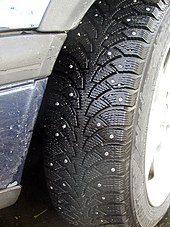Spikes (tires)
When spikes are called in profile tires incorporated pens that the vehicle especially in icy road should give more grip. The use of studded tires is subject to different national legal regulations.
Basics
Winter tires
In winter tires, spikes are additionally vulcanized steel pins or hard metal pins that protrude 1.5–2 mm from the tread. Usually there are between 50 and 150 pieces over the circumference.
The disadvantage is that car tires with spikes have far less grip than pure rubber tires on dry roads. In addition, the roads are subjected to much more stress, and spikes create ruts in the roadway more quickly . When driving with spikes it should be noted that there is a considerably higher rolling noise.
For these reasons, depending on the country, they are only allowed at certain times of the year. In addition, speed limits are usually set. In some countries they are generally prohibited.
In bicycle winter tires , there are two fundamentally different designs. In one design, the spikes are evenly distributed over the entire running surface. Spikes are always off the central tread, but close enough to always grip. But these tires always roll over the spikes. In the other design, the spikes are only on the side of the running surfaces. When the tire is fully inflated, the spikes only have contact with the road when cornering. In winter road conditions, these tires are driven with an air pressure reduced by approx. 1 bar, which means that the spikes come into contact with the road. The main purpose of the spikes in this design is to prevent the wheel from slipping sideways. Bicycle tires usually have 120 to 240 studs per wheel . They have been common in Germany since the early 1990s .
Spikes in sports
On the ice speedway and other special sports tires, the spikes can take on much larger dimensions.
photos
National regulations
See also: Winter equipment: national regulations , overview
Germany
Since 1975, spikes have been generally prohibited for vehicles (with the exception of emergency vehicles) as they can damage the road surface (Section 36 (1) StVZO ). The only exception is the small German corner from Lofer to Bad Reichenhall and within 15 km along the Austrian border .
The admissibility of studs on bicycle tires is unclear. The wording of the law relates on the one hand to "vehicles" (including bicycles), on the other hand, the ban on spikes results from the sentence "Tires or other treads must not have any unevenness that could damage a solid road surface". Therefore, according to the interpretation of the ADFC, studded tires are permitted for bicycles in road traffic, since damage to the road surface by a cyclist with studded tires cannot be assumed.
Austria
In Austria, spikes are prohibited from June to September. Vehicles with spikes must have a sticker that is attached to the rear. Studded tires must be used on all wheels that transmit power to the road surface. If the towing motor vehicle is equipped with studded tires, the towed trailer also needs studded tires up to a maximum axle load of 1800 kg. The maximum speed is 80 km / h on open-air roads and 100 km / h on motorways . They are only allowed for vehicles up to 3.5 t. The spikes themselves may protrude a maximum of 2 mm above the running surface.
Switzerland
They are allowed from November 1st to April 30th. The maximum speed is 80 km / h. Accordingly, the vehicles must be marked at the rear with a maximum speed sign with the number «80». The spikes may protrude a maximum of 1.5 mm. They are not allowed on motorways, exceptions are the San Bernardino tunnel and the Gotthard road tunnel .
Norway
Spikes are allowed from November 1st to the 8th day after Easter Sunday, in the northern districts of Nordland, Troms and Finnmark even from October 16th to May 1st. If the road conditions require it, use outside these times is also permitted.
Finland
Spikes must be mounted on all four wheels. They are generally allowed from November 1st to the first Monday after Easter, depending on the weather, extensions are possible. In winter, the general maximum speed is reduced to 100 km / h.
United States of America
In several states of the USA , spikes are allowed all year round or also banned all year round. In some cases, seasonal or regional restrictions and weather conditions apply. For example, in Hawaii in the Mauna Kea region, the use of spikes is permitted. The current regulations can be found on the Internet.
See also
Web links
- Spike regulations in Europe from the ÖAMTC
- Studded tires for bicycles - experiences and recommendations from ADFC Frankfurt
Individual evidence
- ↑ Winter tires on Fahrradmonteur.de
- ↑ Bicycle spikes: nailing through the winter in the saddle. Spiegel Online from October 10, 2005
- ↑ Traffic experts call for studded tires for public transport!
- ↑ Cycling in winter - rules of conduct. In: adfc.de. ADFC , accessed December 14, 2013 .
- ↑ Regulations and information for drivers in Norway
- ↑ Regulations for spikes in the USA Overview at tiretrack.com (accessed on August 27, 2019)






